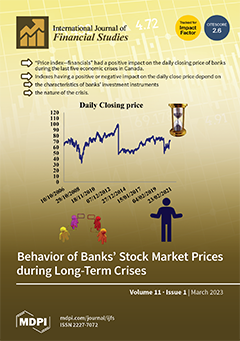The aim of this paper is to provide empirical evidence about the effect of organizational competition (
OC) as a contextual factor on the relationship between the effectiveness of information technology governance (
ITG), which informs accounting information systems, and the
[...] Read more.
The aim of this paper is to provide empirical evidence about the effect of organizational competition (
OC) as a contextual factor on the relationship between the effectiveness of information technology governance (
ITG), which informs accounting information systems, and the financial performance of banks. Financial performance is identified by return on investment (ROI), return on equity (ROE), and Tobin’s Q. Averages of these variables were calculated for five years from 2015 to 2019. In fact, there is evidence for the general argument that banks will improve their performance by implementing
ITG. Specifically speaking, the basic idea presented in this study is that the relation between
ITG and bank performance depends on the appropriate interaction and matching between
ITG and the
OC. The study population includes the senior managers of banks in Jordan. Accordingly, a questionnaire consisting of 16 paragraphs was developed and distributed to senior managers in 23 banks during January to May 2021. As a result, 142 valid questionnaires were collected, which represented 61.7% of the questionnaires expected to be collected. Data are analyzed and processed by using descriptive statistical measures,
t-test, exploratory factor analysis, along with multiple regression. The results show that despite the significant effect of
OC on
ITG, no relation exists between the interaction of
ITG and
OC, and bank performance in the three proxies of performance. The results of the study suggest that either banks do not benefit from
ITG to improve their performance or that the chief executive officers’ perceptions about
ITG in their banks is erroneous. However, it should be clarified that the respondents could have been affected by their values and beliefs when evaluating effective
ITG use in their banks.
Full article





